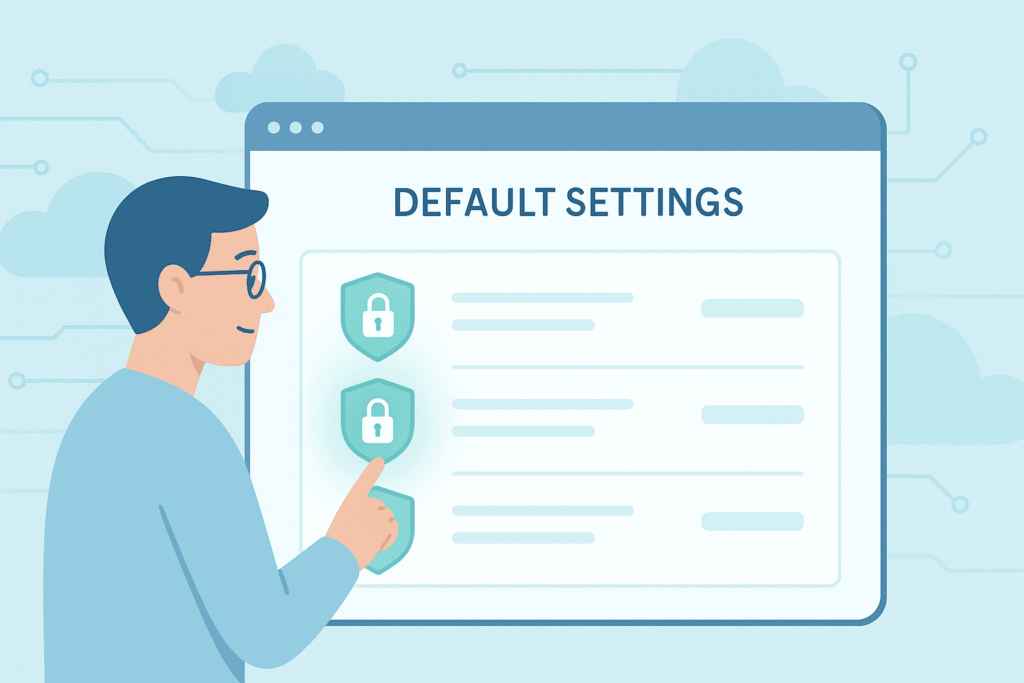
Secure software design principles establish the critical foundation for resilient applications in today’s development landscape. With cyber threats evolving daily, these principles serve as proven guidelines that reduce vulnerabilities throughout the development cycle. Developers who implement these principles from the initial architecture phase create systems that better withstand attacks while maintaining data integrity.
Rather than treating security as an aftermarket feature, organizations now recognize that protective measures must be woven into every stage of software creation. When properly applied, these foundational elements help teams identify potential weaknesses before they become costly breaches.
Read on to explore the key principles that safeguard modern software systems.
Key Takeaways
- Secure software design principles minimize vulnerabilities through controlled access points, multi-layered protection, and streamlined architecture.
- Implementation demands systematic oversight, security automation tools, and balanced user security measures.
- Security design integrates deeply with development cycles, from initial planning through post-deployment monitoring.
The High Cost of Insecure Software
Organizations face mounting financial pressure from security oversights in software design. Recent data shows security breaches reached a staggering $4.45 million average cost per incident during 2023. Moreover, the latest IBM Cost of a Data Breach Report reveals that by 2024, that average rose further to US$ 4.88 million, a 10 % increase year-on-year. [1] Yet the damage extends beyond financial statements, customer confidence plummets while business operations grind to a halt.
Bad actors don’t need sophisticated tools anymore, they simply exploit basic design oversights to gain unauthorized access, extract sensitive data, or disrupt critical services. Most concerning? These vulnerabilities often stem from fundamental design flaws missed during architecture planning, not just coding errors.
The message rings clear: secure design principles provide the bedrock for resilient software. Adopting them early prevents costly retrofitting and reduces organizational risk exposure down the line.
TL;DR: Core Secure Software Design Principles
Here’s a quick overview of the main principles that guide secure software design:
| Principle | Description |
| Least Privilege | Restrict access to the minimum necessary. |
| Defense in Depth | Use multiple security layers. |
| Separation of Duties | Distribute responsibilities. |
| Secure Defaults | Most secure settings by default. |
| Fail Safe Defaults | Deny access unless explicitly allowed. |
| Economy of Mechanism | Simplicity in design and implementation. |
| Complete Mediation | Validate every access attempt. |
| Open Design | Rely on publicly reviewed security mechanisms. |
| Least Common Mechanism | Minimize shared resources across users. |
| Psychological Acceptability | Security features should be usable and intuitive. |
| No Security Guarantee | Acknowledge imperfection and adapt. |
| Security as Code (SaC) | Automate and integrate security checks. |
Secure Software Design Principles: Actionable Steps
Least Privilege: Grant Only Necessary Access
Key components of least privilege implementation:
- Map specific permissions to defined job roles
- Remove access immediately when roles change
- Conduct quarterly permission audits
- Document each access level and its justification
Limiting access permissions stands as a fundamental security practice, users and processes should receive minimal rights needed for their tasks. Through role-based access control (RBAC), organizations can map specific permissions to job functions, preventing unnecessary system exposure.
Take a content management system, writers need article editing access, but shouldn’t touch server configurations. Regular permission audits ensure access stays current as roles change.
Defense in Depth: Implement Multiple Security Layers
Essential security layers include:
- Network-level protection (firewalls, IDS/IPS)
- Application security measures
- Data encryption at rest and in transit
- Continuous monitoring and logging
- Regular penetration testing
Multiple defensive layers provide overlapping coverage. When one safeguard fails, others maintain protection. A bank vault doesn’t rely solely on thick walls, it combines reinforced doors, time locks, surveillance, and alarm systems. Similarly, software needs varied security mechanisms working in concert. Small teams benefit just as much as enterprises from this layered approach.
Separation of Duties: Distribute Critical Responsibilities
Critical operations to separate:
- Code development and deployment
- Security testing and approval
- Production access management
- Audit log reviews
Breaking up critical operations among different roles creates natural oversight. Code deployment serves as a prime example: developers write code, security teams analyze vulnerabilities, while operations handles production deployment. This distribution prevents both accidental mistakes and intentional misuse.
Secure Defaults: Set the Most Secure Initial Configurations

Essential secure default settings:
- Enforced strong password policies
- Enabled multi-factor authentication
- Disabled unnecessary services and ports
- Encrypted data storage and transmission
Default configurations shape how users interact with software from day one. Most users never change initial settings, making secure defaults and fail-safe design crucial for ongoing protection. Strong security measures activated from the start prevent common vulnerabilities that arise from misconfigured systems.
Fail Safe Defaults: Deny Access by Default
Core principles of fail-safe implementation:
- Block all access paths initially
- Require explicit permission grants
- Log all access attempts
- Review denied requests regularly
Systems must default to denial when handling access requests. This approach prevents unauthorized access during system failures or attacks. Recent incidents show how permissive defaults lead to data breaches, organizations learn this lesson the hard way when sensitive information leaks through overlooked access points.
Economy of Mechanism: Keep Design Simple
Simple design focuses on:
- Minimal moving parts
- Clear data flows
- Standardized security controls
- Reduced attack surface
Complexity breeds security holes. Straightforward systems prove easier to secure, test, and maintain over time. Security audits run smoother on simple architectures, while streamlined code allows faster vulnerability detection. Each additional feature or integration creates new potential weak points.
Complete Mediation: Validate Every Access Attempt
Every system interaction requires:
- Fresh authentication checks
- Current authorization validation
- Resource access verification
- Detailed access logging
No access request should skip verification, regardless of previous authorizations. Continuous validation prevents attackers from exploiting outdated permissions or cached credentials. While some view repeated checks as excessive, they form a critical defense against privilege escalation attempts.
Open Design: Use Well-Tested, Publicly Reviewed Practices
Key aspects of open design security:
- Industry-standard encryption protocols
- Peer-reviewed security frameworks
- Documented security policies
- Regular third-party audits
Hiding security mechanics creates false confidence. Proven, publicly scrutinized security measures withstand real-world threats better than proprietary solutions. Security standards undergo constant expert examination, exposing weaknesses before attackers exploit them.
Following a secure design principles overview helps teams align their architecture with well-established, peer-reviewed security frameworks instead of building from scratch.
Least Common Mechanism: Minimize Shared Resources

Critical isolation strategies:
- Container-based deployments
- Dedicated user workspaces
- Separate processing environments
- Resource access boundaries
Shared resources create security vulnerabilities. When multiple users or processes access the same components, risks multiply. Modern containerization technology enables practical isolation, each process runs in its own secure environment. This separation prevents security incidents from spreading across system boundaries.
Psychological Acceptability: Make Security Usable
User-friendly security features include:
- Single sign-on capabilities
- Clear security notifications
- Intuitive permission settings
- Streamlined authentication flows
Security measures fail when users can’t understand them. Complex security procedures lead to dangerous shortcuts, like posting passwords on monitors or sharing login credentials. In fact, according to Verizon’s 2024 Data Breach Investigations Report, 68 % of data breaches involve a non-malicious human element (such as user error or social engineering). [2]
Effective security must blend into natural workflows, protecting systems without frustrating users. Regular user feedback helps refine security features for better adoption.
No Security Guarantee: Continuously Test and Adapt
We never promise perfect security because no system is flawless. Instead, we embrace ongoing testing, monitoring, and adaptation. Threats evolve, so must defenses.
Our training emphasizes vulnerability assessments, penetration testing, and continuous security monitoring as part of a living security program. Recognizing imperfection keeps teams vigilant and responsive.
Security as Code (SaC): Automate Security Checks
Manual security checks are slow and error-prone. Security as Code integrates automated security tooling directly into the development pipeline.
We teach how to embed vulnerability scanning, configuration checks, and policy enforcement into CI/CD workflows. Automation helps catch issues early and speeds up remediation, making security a continuous part of software delivery.
Applying Secure Design Principles: A Continuous Process
Credits: IBM Technology
Secure software design is not a one-off task. It’s woven into every phase of the software development lifecycle (SDLC). From threat modeling during the secure SDLC, through coding with secure standards, to deployment with hardened configurations and ongoing monitoring, security is constant.
Our experience shows that teams who integrate these principles early and automate enforcement produce more resilient software that meets compliance and customer expectations. Regular audits, patch management, and developer training complete the cycle.
Keeping security front and center requires commitment but pays off by reducing risk and improving trust. We help developers and teams build those habits through hands-on training and real-world practice.
FAQ
How does security by design improve software reliability throughout the secure SDLC?
Security by design ensures that software security best practices are integrated from the very beginning of the secure development lifecycle (secure SDLC). Instead of adding security controls after coding, teams incorporate threat modeling, secure software architecture, and risk mitigation into every phase.
This approach helps minimize the attack surface, enforce secure defaults, and prevent security flaws. As a result, it strengthens data confidentiality, data integrity, and system availability while maintaining compliance requirements and effective security governance.
Why is the principle of least privilege essential for preventing privilege escalation and protecting data confidentiality?
The principle of least privilege limits users, processes, and services to only the permissions required to perform their functions. This restriction helps prevent privilege escalation and reduces the risk of unauthorized data access.
By applying identity and access management, role-based access control (RBAC), and access control lists (ACLs), organizations can maintain secure defaults and enforce deny by default settings. These layered security controls, combined with secure configuration and secure infrastructure, significantly reduce the likelihood of system compromise.
How do defense in depth and separation of duties contribute to a more secure software architecture?
Defense in depth enhances secure software design by applying multiple, independent layers of security controls across an application. Examples include using strong authentication, multi-factor authentication, encryption best practices, and secure API design.
Separation of duties ensures that no single person or process can bypass critical security mechanisms or alter configurations unchecked. Together, these principles strengthen application security, reduce shared resources, and support compliance with established security frameworks and governance policies.
What role does DevSecOps play in continuous security monitoring and effective vulnerability management?
DevSecOps integrates security as code into every stage of the software development process. Automated security testing, dependency scanning, and hardcoded secret detection occur alongside code review and peer review. Continuous security monitoring helps identify vulnerabilities early, while patch management and threat intelligence integration enable faster response to cyber threats.
By enforcing secure deployment, secure cloud development, and secure system configuration, DevSecOps ensures that software vulnerability management remains consistent and proactive.
How do secure coding and secure containerization reduce risks in modern microservices-based applications?
Secure coding practices, including strict input validation, output encoding, and adherence to secure coding standards, help prevent injection flaws, data leaks, and other vulnerabilities. In microservices security, secure containerization isolates each service to minimize the attack surface and improve system availability.
Secure infrastructure, secure network architecture, and security automation further enhance protection. Combined with secure code repositories, effective incident response, and business continuity planning, these measures ensure reliable software asset inventory and strong risk mitigation across all deployments.
Building Resilience with Secure Software Design Principles
When you apply secure software design principles, like least privilege, defense in depth, and simplicity, you’re not just coding; you’re building trust. These practices reduce vulnerabilities and strengthen every layer of your system. Security isn’t an afterthought, it’s the foundation.
Ready to code with confidence? Join the Secure Coding Practices Bootcamp to master hands-on techniques for writing safer, stronger applications from day one.
References
- https://wp.table.media/wp-content/uploads/2024/07/30132828/Cost-of-a-Data-Breach-Report-2024.pdf
- https://www.helpnetsecurity.com/2024/05/02/verizon-2024-data-breach-investigations-report-dbir/

